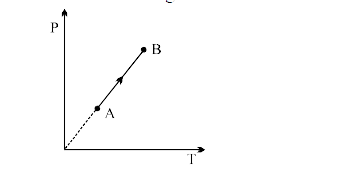Select the appropriate property of an ideal gas
its molecules are infinitesimally small
There are no forces of interaction between its molecules
It strictly obeys the ideal gas laws
All of these
The correct Answer is:D
To select the appropriate property of an ideal gas, we need to analyze the characteristics of an ideal gas based on the information provided.
1. Definition of Ideal Gas: An ideal gas is a theoretical gas composed of many particles that are in constant random motion. The interactions between these particles are negligible.
2. Molecular Size: The molecules of an ideal gas are considered to be point particles, meaning their volume is negligible compared to the volume of the gas itself. This aligns with the first property mentioned.
3. No Intermolecular Forces: In an ideal gas, it is assumed that there are no forces of attraction or repulsion between the molecules. This means that the molecules do not interact with each other, which is a key characteristic of an ideal gas.
4. Elastic Collisions: The collisions between the molecules of an ideal gas are perfectly elastic. This means that there is no loss of kinetic energy during collisions, which is another important property of ideal gases.
5. Obeying Ideal Gas Laws: Ideal gases strictly follow the ideal gas laws (PV=nRT), which describe the relationship between pressure (P), volume (V), temperature (T), and the number of moles (n) of the gas.
6. Conclusion: Based on the properties discussed, we can conclude that all the options provided are true regarding the properties of an ideal gas. Therefore, the correct answer is "All of these".
Final Answer:
The appropriate property of an ideal gas is that all of the mentioned properties are true.
---
The appropriate property of an ideal gas is that all of the mentioned properties are true.
Topper's Solved these Questions
- BOOK - AAKASH INSTITUTECHAPTER - KINETIC THEORYEXERCISE - EXERCISE (ASSIGNMENT) SECTION - B Objective Type Questions30videos
KINETIC THEORY
- BOOK - AAKASH INSTITUTECHAPTER - KINETIC THEORYEXERCISE - EXERCISE (ASSIGNMENT) SECTION - C Previous Years Questions21videos
KINETIC THEORY
- BOOK - AAKASH INSTITUTECHAPTER - KINETIC THEORYEXERCISE - EXERCISE10videos
KINETIC THEORY
- BOOK - AAKASH INSTITUTECHAPTER - GRAVITATION EXERCISE - ASSIGNMENT SECTION - D (ASSERTION-REASON TYPE QUESTIONS)16videos
GRAVITATION
- BOOK - AAKASH INSTITUTECHAPTER - LAWS OF MOTIONEXERCISE - Assignment (SECTION-D) (Assertion-Reason Type Questions)15videos
LAWS OF MOTION
Similar Questions
Knowledge Check
- Question 1 - Select One
For an ideal gas,
Athe change m internal energy in a constant pressure process from temperature T1 to T2 is equal to, nCv(T2−T1), where Cv is the molar specific heat at constant volume and n is the number of moles of the gasBthe change in internal energy of the gas is equal to the work done by the gas in magnitude in an adiabatic process.CThe internal energy shows no change in an isothermal processDAll of options A, B and C - Question 2 - Select One or More
For an ideal gas :
AThe change in internal energy in a constant pressure process form temperatures T1 and T2 is equal to nCv(T2−T1) where Cv is the molar heat capacity at constant volume and n is the number of moles of the gasBThe change in internal energy and the work done by the gas are equal in magnitude in an adiabatic processCThe internal energy does not change in isothernal processDno heat is added or removed in an adiabatic process - Question 3 - Select One or More
For an ideal gas :
Athe change in internal energy in a constant pressure process from temperature T1→T2 is equal to nCv(T2−T1), where Cv is the molar specific heat at constant volume and n the number of moles of the gas.Bthe change in internal energy of the gas and the work done by the gas are equal in magnitude in an adiabatic process.Cthe internal energy does not change in an isothermal process.Dno heat is added or removed in an adiabatic process.
What is an ideal gas ? Explain its main characteristics.
View SolutionProblem on ideal gas
View SolutionSelect the correct option(s) for an ideal gas.
View SolutionSelect the correct option for an ideal gas undergoing a process as shown in diagram.
 View Solution
View SolutionSelect the correct statement for an ideal gas undergoinf reversible or irreversible adiabatic process from same initial process
View Solution

